日本独特の夏の風物詩といえば、背筋も凍る「怖い話」。他の国ではなかなか聞かない、ユニークな「涼み方」ですよね。日本と言えばエキセントリック、というイメージを持っている外国人にとっては興味をそそる文化なはずです。
この記事では日本の代表的な「妖怪」と、その特徴の英語での説明をまとめました。最近ではあまり聞かなくなった「妖怪」の話は、日本語の訳を読んでいるだけでも珍しく面白いかと思います。ぜひこのまま読み進めて、内容を楽しみつつ英語の説明も参考にしてください。

【この記事を書いているのは…】
由美ギルバート
日英ハーフながら英語が話せず、コンプレックスを抱え10代を過ごす。
ニュージーランド留学を経験し、その後外資企業に勤めTOEIC985点取得。
長野県白馬村でインバウンド系旅行会社に勤め、オーストラリア人の誘致に携わったのち、イギリスに渡り現地旅行会社で勤務。
現在はWebライターとして、英語に対する無類のパッションを共有すべく執筆活動しているアラフォー。
英語記事:
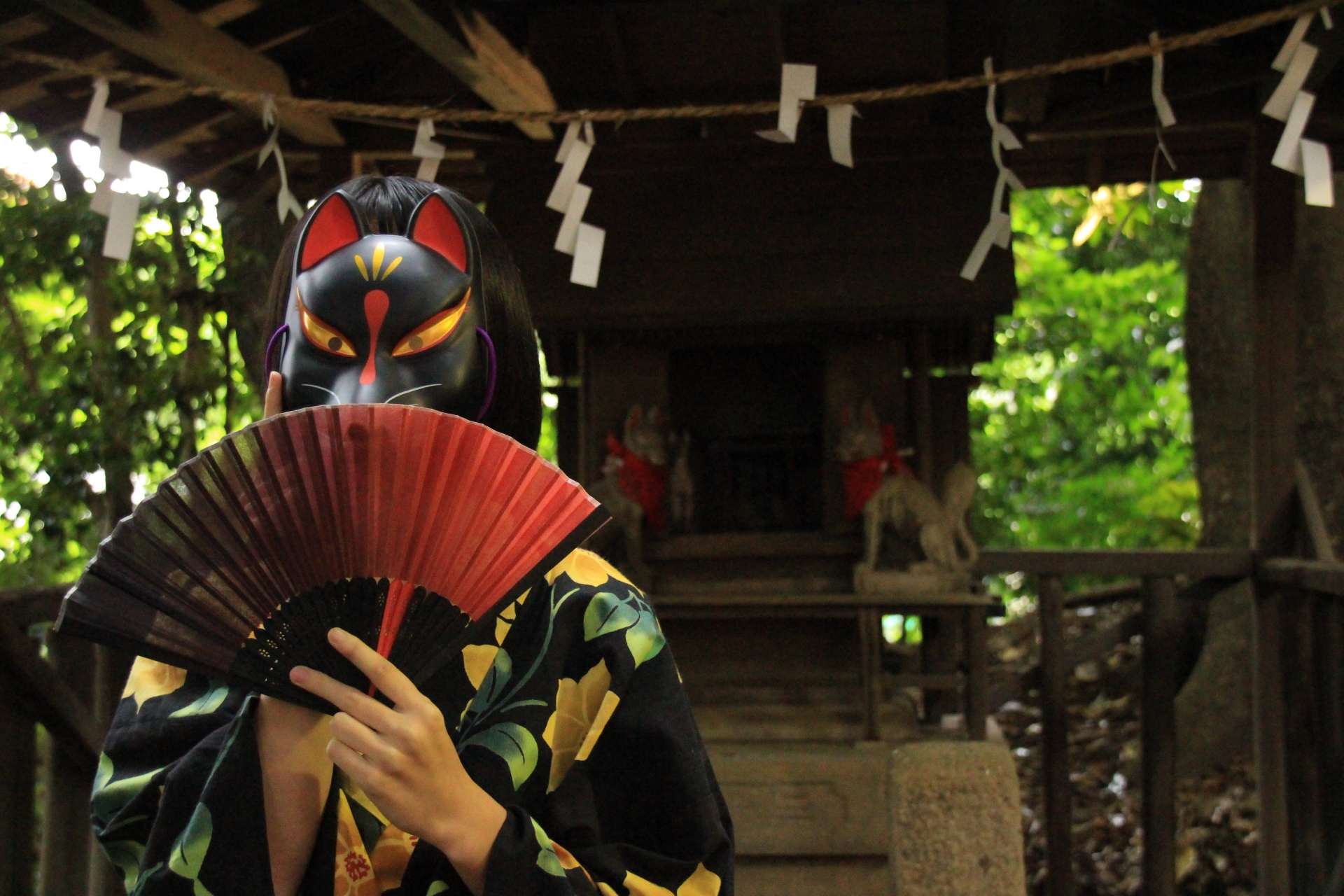
「妖怪」は英語で何と言う?
英語では「妖怪」をどう説明するか、外国人の目線も忘れずに例を見ていきましょう。
Yokai are a type of monsters that are often featured in scary Japanese folk stories.
妖怪はモンスターのようなもので、しばしば日本の怖い昔話に登場します。
To make a long story short, Yokai are basically results of how people tried to explain mysterious phenomenons back in the olden days.
要約すると妖怪は基本的に、昔の人が不可解な現象を説明しようとした結果です。
There are many types of Yokai, some more scary than others and a few of them are even sort of cute!
沢山の妖怪の種類があり、いくつかは他より怖くて、またいくつかは何だかキュートです!
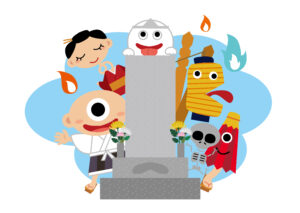
ここからは、代表的な妖怪を取り上げていきます。
「鬼」を英語で説明
それでは妖怪の代名詞とも言える、鬼の英語での説明をみていきましょう。
「鬼」とは
Oni are equivalent to Western ogres or demons, who originally live in hell but also like desolate places like remote islands or abandoned fortresses.
鬼は西洋のオーガや悪魔と同じもので、もともとは地獄に住んでいますが、人里離れた無人島や廃墟となった要塞も好みます。
Common Oni depictions are somewhat similar to humans but have either red or blue colored skin, have horns growing out of the top of their heads and wear tiger-striped shorts.
一般的な鬼の描写はなんとなく人間に近いですが、赤かもしくは青の肌色をしていて、頭のてっぺんから角が生え、トラ柄の短パンを履いています。
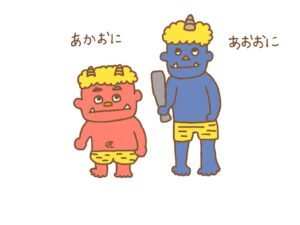
「鬼」は何をする
They are very strong and fearsome, and they bring disaster and disease with them.
鬼はとても強く恐ろしく、災害と病気をもたらします。
In hell, it is their job to torture the damned souls not unlike Western demons.
西洋の悪魔とは違い、呪われた魂を拷問するのが地獄での鬼の仕事です。
「天狗」を英語で説明
現代でもお店などの名前に使われている人気者の天狗。ぜひ英語でも説明できるようにしておきましょう。
「天狗」とは
Tengu is a red-faced and long-nosed legendary creature with wings, whose sole purpose is to distract people from the path to enlightenment, the ultimate goal in Buddhism.
天狗は伝説的な生き物で「赤い顔」「長い鼻」や「羽」をもち、仏教の究極のゴールである「悟り」への道を邪魔するのが唯一の目的です。
Even though Tengu sometimes abduct and torture humans, a more common story is that Tengu are mischievous and trick humans by giving them false advice.
天狗はたまに人間を連れ去り拷問しますが、もっとも知られているのは天狗が悪戯好きで人間をウソの助言で騙すという話です。
The word Tengu is still used in Japanese today, which is to describe braggarts.
天狗という言葉は現代の日本語でも「自慢する人」を表す時に使われます。
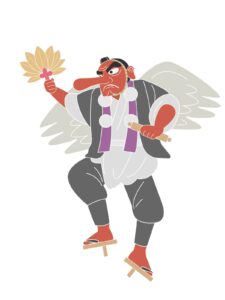
「天狗」が祀られている理由
You might be confused when you find some shrines enshrine Tengu as a messenger of the deity.
天狗を神々の使者として崇拝している神社を見つけた時は混乱するかもしません。
It is believed that if something bad happens to worshipers, Tengu will fly out to help them and ward off the evil spirits.
崇拝する者に何か悪い事が起きた場合に、天狗が飛んできて魔除けしてくれると信じられています。
「河童」を英語で説明
最近はかわいいキャラクターとして見ることが多い河童も実はダーク。妖怪なのになぜか礼儀正しい「弱点」も説明できれば、笑いを誘うかもしれません。
「河童」とは
Kappa is a water monster, and while his depiction often looks cute today, he has a dark side.
河童は水中のモンスターで、今日はかわいい描写がされる事が多いものの邪悪な側面があります。
Looking like a cross-over between a turtle and a human, they live in the water and are mainly known for drowning people who come too close to the water.
亀と人間の中間のような見た目で水中に暮らしていて、水に近づきすぎた人々を溺れさせることで主に知られています。
Warning kids to stay away from Kappa by not coming too close to the water has actually been a popular way to prevent them from drowning.
子供に河童に近づかないように注意する事で、水に近づかせないようにする方法は、溺れるのを防ぐために実際によく使われています。

日本らしい「河童」の弱点
Kappa have a dish on their head that is filled with water, and it is said that if the water falls off the dish they will become incapacitated.
河童は頭の上に水の張ったお皿があり、お皿から水がこぼれると無力になると言われています。
Because of this, there is a very handy way to deal with a dangerous Kappa; make a bow to them, as then they have to bow back and they will lose their water as a result.
このため、危険な河童に対処するためのとても便利な方法があります。お辞儀をすると、河童もお辞儀をし返さないといけないため、結果として水を失います。
「座敷童」を英語で説明
なかなか珍しく、一緒にいると幸運になれる妖怪である「座敷童」。現代でもたまに話題になりますよね。英語の説明には以下の例があります。
「座敷童」とは
These mischievous but friendly spirits live in the reception room of a traditional Japanese house, and as long as they are with you, it is believed that you will prosper.
悪戯っぽくフレンドリーなこの魂は、伝統的な日本の家の応接間に住んでいて、一緒にいる限り繁栄すると考えられています。
If you would chase it away, your fortunes may become very bad, so it is better to keep a good relationship with them.
もし追い出したら大変な不運になるかもしれないので、よい関係を保つ方が良いです。
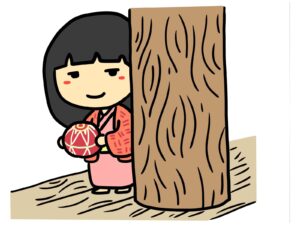
「座敷童」はいたずら好きの子供
They look like they are around 6 years old with a blushing faces, and they can be either a boy or a girl.
この妖怪は6歳くらいに見えて、赤ら顔の男の子もしくは女の子です。
Zashiki-warashi behave like the children they are and like to play tricks such as leaving little footprints around the house or making typical kids’ noises such as top-spinning.
座敷童は見た目の通りに子供のように振る舞い、家中に小さな足あとを残す悪戯したり、コマ遊びなどの典型的な子供の音を発します。
「海坊主」を英語で説明
漫画の『シティーハンター』のキャラクターですっかり定着している「海坊主」ですが、実はもともとは古くからいる妖怪です。遭遇した時の対処法も含めて英語の説明をみていきましょう。
「海坊主」とは
The word Umi-bozu literally means ‘sea monk’, and this monster only appears at sea.
海坊主という言葉は文字通り「海の坊主」で、海にしか姿を現さないモンスターです。
It looks like a giant head that unexpectedly appears from calm seawater, making it extra scary.
巨大な頭のようなものが静かな海から突然出てくるので、特段怖いです。
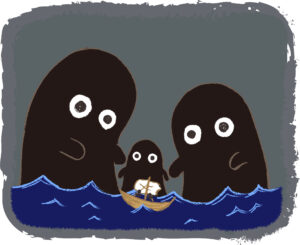
「海坊主」に遭遇した場合
When it comes, it sometimes breaks the ship upon its emergence and if it doesn’t, it requests a bucket from the sailors.
時々姿を現す際に船を壊す事があります、もしそうでない場合は船員にバケツを要求します。
After giving it the buckets, Umi-bozu still drowns the poor souls who had the misfortune to meet it.
バケツをあげても、海坊主は不幸にも遭遇した気の毒な人達を溺れさせます。
But the good news is that there is a way to fool him; if you give him a bucket without a bottom, it will be confused and you can get away.
それでも、幸運にも海坊主を騙す方法があります。底のないバケツをあげると混乱するので、その間に逃げられます。
「猫又」を英語で説明
人間に虐げられた猫がなってしまう「猫又」。英語での説明をみていきましょう。
「猫又」とは
This two-tailed cat yokai is very large and has a palate for human flesh.
この尾が2つある妖怪はとても大きく、人間の味を好みます。
They are also able to shape-shift into humans and deceive people.
人間の姿に変わることもできるため、人間を惑わせます。
Some Nekomata live in the mountains, but there are also house cats that change into Nekomata if they are kept too long.
猫又は山に住みますが、家猫でもあまり長く飼うと猫又に姿を変えるものもあります。
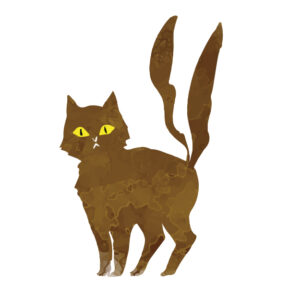
「猫又」への対処法は猫に優しく!
Their power is said to be the strongest in cats that became very old and were treated badly by humans.
人間に虐げられた老い猫が1番魔力が強いと言われます。
If you were one of the humans who wronged the cat, Nekomata would take revenge by sending your dead relatives to haunt you.
もしあなたが猫を不当に扱った人間のうちの一人だったら、猫又はあなたの亡くなった親戚を送り込み、付きまとわせることで復讐します。
「ぬらりひょん」を英語で説明
まるで人間のような妖怪「ぬらりひょん」を、英語で説明してみましょう。
「ぬらりひょん」とは
The Nurarihyon is a yokai who looks a lot like a human, with an elongated head.
ぬらりひょんは人間のような姿をした妖怪で、引き伸ばしたような頭の形をしています。
He is an old man, who wears traditional Japanese robes.
彼は老いた日本人の男性で、日本の伝統的な長衣を着ています。

「ぬらりひょん」は何をする
Nurarihyon literally means something that appears suddenly and then slips away, which is also why it is similar to the Umi-bozu in some regions.
ぬらりひょんは文字通り突然現れてこっそりと居なくなります。そのため海坊主と似ているところがあります。
It is not entirely clear what Nurarihyon’s story was in the feudal time, but in more modern stories he is a yokai who simply enters people’s homes in the evening and just sits down as if it is his home while he smokes and drinks tea.
ぬらりひょんが封建時代にどのような事で知られていたのか不明瞭ですが、現代では夜に人の家に入り込み、まるで家の主かのようにタバコを吸ったりお茶をのんだりするだけの妖怪です。
「鵺(ぬえ)」を英語で説明
平家物語にも記載があり長い歴史のある「鵺」の、英語での説明を見ていきましょう。
「鵺」とは
Nue is a disturbing-looking yokai with a mixture of a monkey, tiger, dog, and snake.
鵺は猿、虎、犬と蛇が混ざった、不安をかき立てるような姿をした妖怪です。
In the 9th century, the monster was already described in the literature as a fearful monster that appears at night and has the ability to turn into a black cloud.
9世紀の書物にはすでに、夜に現れて黒い煙に変わる恐ろしいモンスターとして記されています。
Nue’s bird-like cries are spine-chilling and were believed to be the harbinger of disaster.
鵺は背筋を凍らせるような鳥に似た鳴き声をもち、それは災害の前兆と信じられていました。
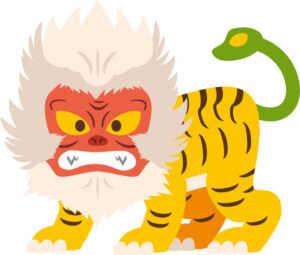
「鵺」と平家物語
In the Heike Monogatari, a book that describes the fate of the then famous Taira clan, one of the stories is about the slaying of the Nue in the 13th century.
当時名前が知れ渡っていた平家一族の運命を書き記した平家物語にも、13世紀の鵺の退治について記載があります。
The Emperor fell ill while the cries of the Nue were heard, and hero Minamoto no Yorimasa managed to shoot Nue with a special arrow.
鵺の鳴き声が聞かれるとともに天皇が病になったため、源頼政という英雄が特別な弓で鵺を仕留めました。
After the monster died and came down in Nijo Castle in Kyoto, they heard the cries of the normal cuckoo and the Emperor recovered.
そのモンスターが息絶えて京都の二条城に落ちた後、いつも通りのカッコウの鳴き声が聞こえ天皇が回復しました。
「塗り壁」を英語で説明
『ゲゲゲの鬼太郎』のメインキャラクターとしても知られる「塗り壁」。下記はこのシュールな妖怪の英語での説明の一例です。
「塗り壁」とは
Nurikabe literally means ‘plastered wall’, and it is pretty much that, a wall that blocks people from getting to their destinations.
塗り壁は文字通り「しっくいを塗った壁」で、その名の通り人々が目的地に行くのを壁で塞ぎます。
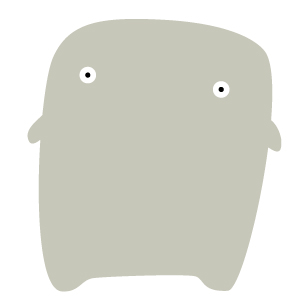
道に迷うのは「塗り壁」の仕業
Many ghost stories came about to try to explain mysteries, and the story of the Nurikabe is no different.
多くのお化けの逸話は不可解な出来事を説明するためのものですが、塗り壁の場合も同じです。
Before the invention of the smartphone it was easy to get lost while traveling, and when it happened people felt like there’s an invisible wall that extended forever. Nurikabe was one explanation for this perplexity.
スマートフォンが発明される前は、道中で迷うのが常で、その時はまるで見えなくて永遠に広がる壁があるように人々は感じたものです。この難問の説明の一つが塗り壁です。
「がしゃどくろ」を英語で説明
大きな骸骨がなんとも妖怪らしく怖い「がしゃくどろ」。英語の説明をみていきましょう。
「がしゃくどろ」とは
Gashadokuro is a giant skeleton that is about 15 times larger than a normal human that is built up from the bones of those who died in a bad way and weren’t buried properly.
がしゃくどろは人間の15倍位のサイズの大きな骸骨で、その骨は不慮の死を遂げちゃんと埋葬されなかった人々の骨が集まったものです。
They die of things like starvation or plague, and when they become Gashadokuro they prey upon lone travelers at night.
飢餓や疫病などが死因で、がしゃくどろになった際には単独の旅人を餌食にします。
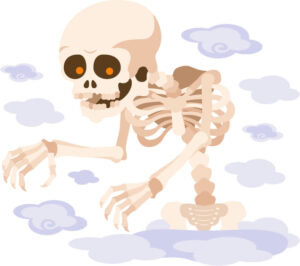
「がしゃくどろ」から身を守るには
You can hear them coming because their teeth rattle loudly, but because the people are already dead you can’t defeat them and death is certain when they come for you.
がしゃくどろが近づくと歯がガタガタと大きな音をたてるのが聞こえます。ただ、既に亡くなった人々のため打ち倒すことは出来きず、また狙われたら死は免れません。
Luckily there are said to be Shinto charms (omamori) that can ward them off, and once they have taken out all their anger on the living, Gashadokuro will collapse and no longer be a nuisance.
幸運にも神道のお守りが彼らを近づけないとされ、がしゃくどろは全ての怒りをこの世の人に発散させると崩れ落ちて悪さをしなくなります。
「からかさ小僧」を英語で説明
海外では「からかさ」はインテリアにつかわれたりしますが、日本人が「からかさ」と聞くと妖怪の「からかさ小僧」が浮かぶ人が多いのではないでしょうか。外国人目線で見ると意外にも繋がりを感じられる「物を捨てる」ことに対する日本人の意識、も一緒に説明してみましょう。
「からかさ小僧」「傘お化け」とは
This yokai is a bit funny, as Kasa-obake looks like an umbrella that jumps around on its one leg.
この妖怪はちょっと面白く、この「傘お化け」は、傘が一本の脚で飛び跳ねているように見えます。
They tend to appear on rainy and windy days, and in some regions, it is said that Kasa-obake can lift people into the air after which they either crash back to the ground or disappear forever.
大抵雨や風が強い日に現れ、いくつかの地域ではこの「傘お化け」が人を空中に浮かせる事ができ、その人はそのまま墜落するか消えて居なくなってしまう、と言われています。
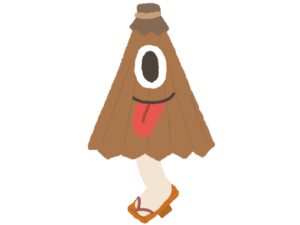
「からかさ小僧」は「捨てられない」日本人の象徴?
In Japan, it is believed that objects are capable of having a spirit, and it is said that when things get older they are more likely to get spirits.
日本では物は魂を持つ事ができて、古いものほど魂を持つ可能性があると言われています。
This may be one of the reasons that many Japanese people have a hard time throwing away their things, and cleaning guru Marie Kondo invented her ‘throwing away ceremony’ to make that process a bit easier.
これは日本人が物を捨てるのを嫌がる理由の一つかも知れません。片づけの達人の近藤麻理恵さんが捨てるための儀式を考案し、捨てることを少し気楽にさせてくれました。
まとめ
今回は「妖怪」の英語での説明をまとめました。最近では聞くことが少なくなった「妖怪」の話は、外国人も日本人にも楽しめる内容ですよね。怖いものから、なんだか笑っちゃうものまで網羅している「妖怪」を英語で説明できれば、きっと話に花が咲くはずです。ぜひ、チャレンジしてみてください。
ガイドコミュニティ・JapanWonderGuideに参加しませんか?

JapanWonderGuide(JWG)は「日本のガイドの質を世界一に」をスローガンに掲げるガイドコミュニティです。2020年から活動を開始し、全国通訳案内士等を中心に、現在は、2,000名を超えるコミュニティとなっております。
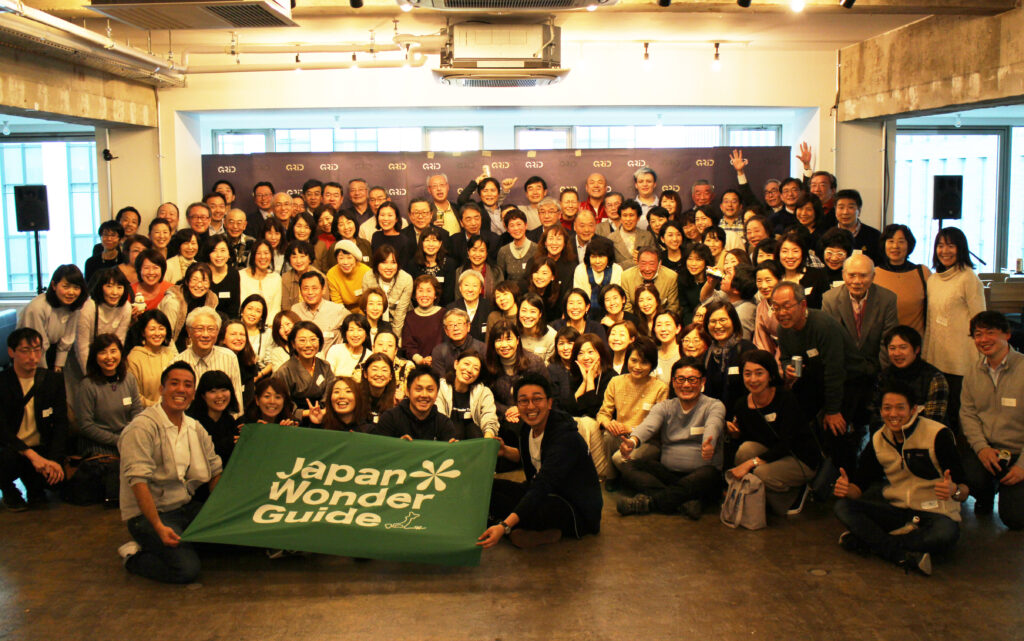
JWGの有料会員(KNOTTER)にご登録いただくと、月額1,000円(税込1,100円)で、ガイディングやビジネスに活きる知識・スキルが身につくE-Learningが受講し放題!ガイドのスキルアップに特化した研修動画を、お好きなだけ、無料でご視聴いただけます。
さらに、KNOTTERになると、通訳案内士が5年ごとに必ず受講しなければならない「通訳案内研修」を、オンラインで、無料でご受講いただけます。そのほか、下見やツアー時に割引/無料でご入場いただける優待施設のご利用や、人気観光施設の最新情報や裏話をお届けするJWG Live!の見逃し配信、各研修の割引など、様々な特典をご利用いただけます。
有料、無料会員様ともに研修やイベント情報など、ガイドに役立つ内容がたっぷり詰まったメルマガを月に2回お届け。また、ガイド仲間を見つけ、交流できるFacebookグループにもご招待!情報交換の場としてお使いください。
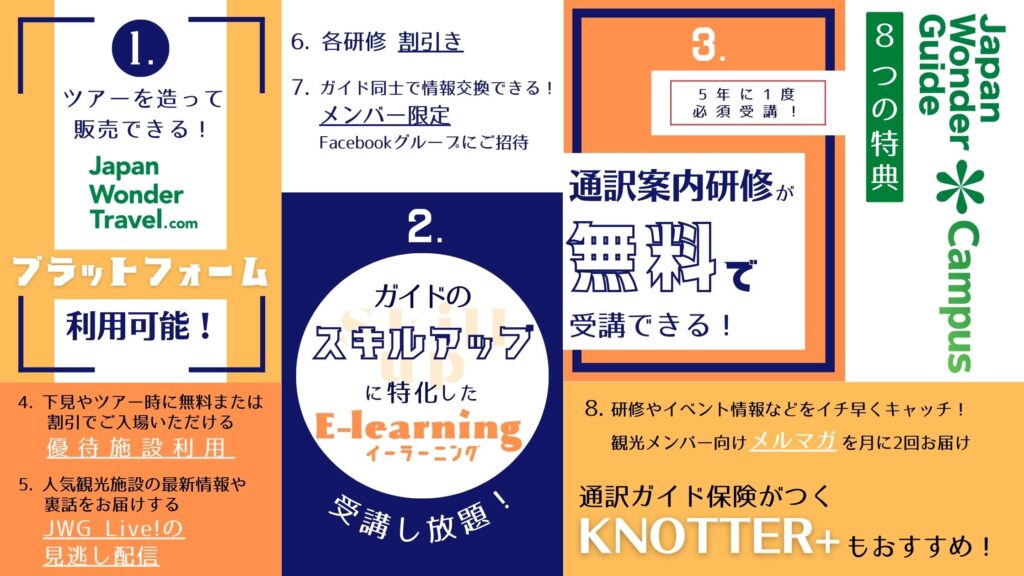
| フリーメンバー | KNOTTER | KNOTTER+ | |
| 料金 | 無料 | 月額1,000円 (税込1,100円) | 年間14,000円※ (税込15,400円) |
| 期間 | 無期限 | 毎月自動更新 | 2023年8月31日まで |
| ①Japan Wonder Travel プラットフォーム利用 | ○ | ○ | ○ |
| ➁メンバー限定Facebookグループご招待 | ○ | ○ | ○ |
| ③メンバー向けメルマガ受信 | ○ | ○ | ○ |
| ④JWG Live!見逃し配信 | △ | ○ | ○ |
| ⑤優待施設利用 | – | ○ | ○ |
| ⑥JWG主催研修割引 | – | ○ | ○ |
| ⑦通訳案内研修 | – (3,500円) | 無料 | 無料 |
| ⑧E-learning動画配信 | 有料 | 無料 | 無料 |
| ⑨通訳ガイド保険 | – | – | ○ |
※KNOTTER+の会費は加入月によって変動します
★通訳ガイド保険がついたKNOTTER+もご用意しております。資格の保有の有無に関わらず、通訳案内業務が補償の対象となりますので、どなたでも安心してガイドのお仕事をしていただけます。
インバウンド復活の兆しも少しずつ見えてきました。ぜひこの機会にご検討ください。
JWGで、日本の観光を一緒に盛り上げていきませんか?

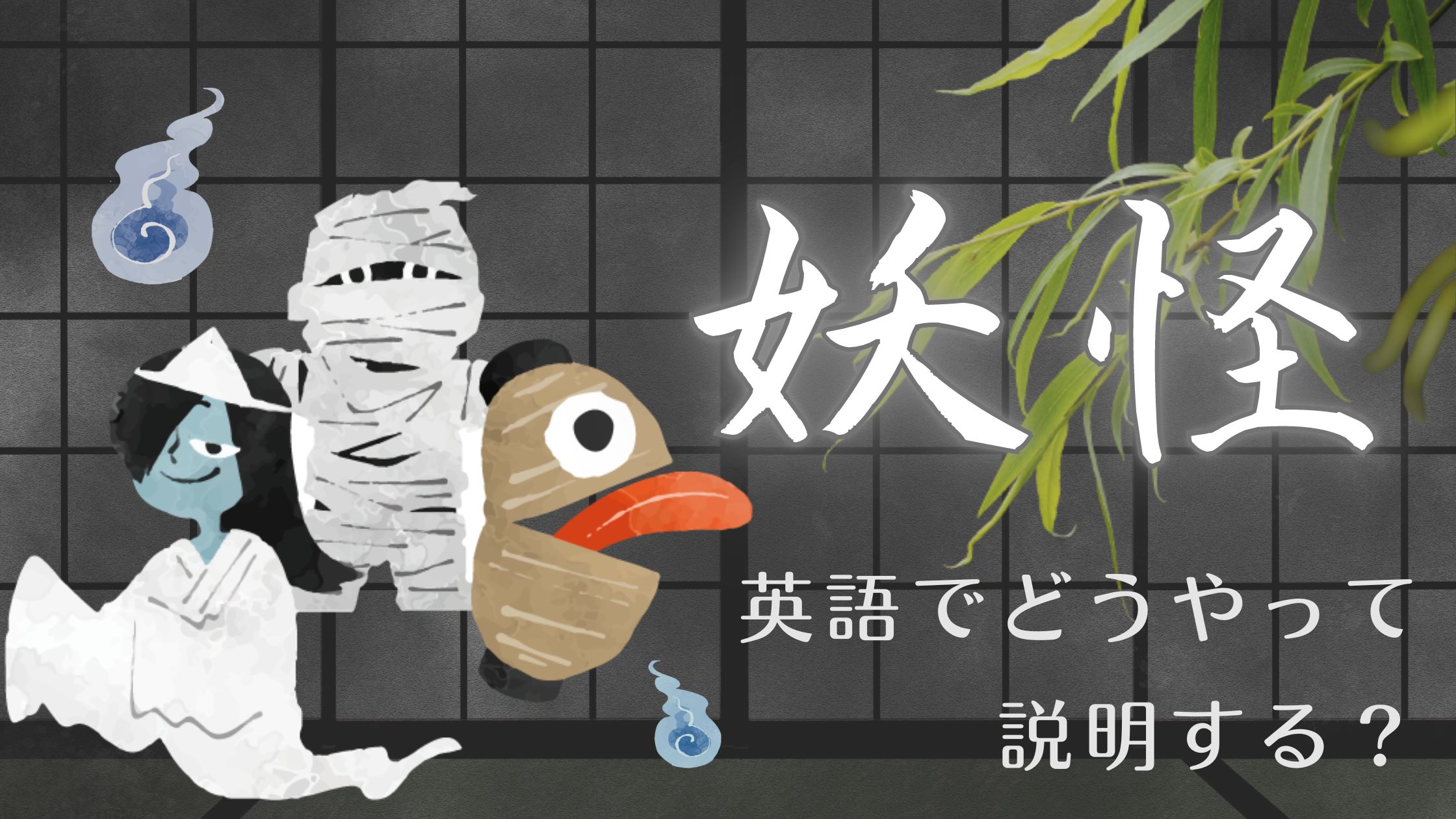





コメント